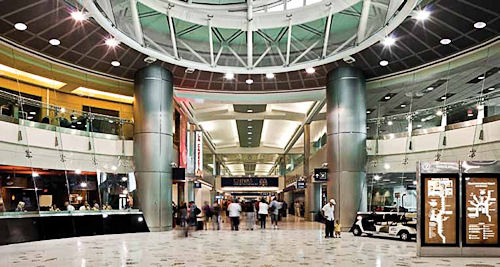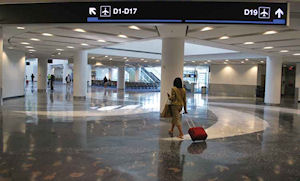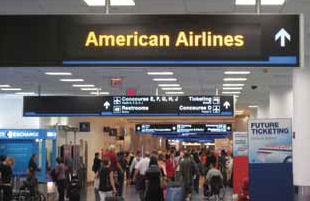Miami Int'l Nears Completion of $2.94 Billion North Terminal

|
Facts & Figures Project: North Terminal Development Location: Miami International Airport Building: 3.5 million sq. ft. Cost: $2.94 billion Project Completion: 2011 General Contractor: Parsons Odebrecht Joint Venture Original Concept/Schematic Design Architect: Corgan Associates Design Management/Integration & Project Management: Heery-S&G Program Management/Construction Administration: Heery, Sequeira & Gavarrete Special Systems Project Manager: Ross & Baruzzini Construction Documents: Leo A Daly, Bermello, Ajamil & Partners, Wolfberg, Alvarez & Partners, MC Harry, Harpe Partners, Perez & Perez, The Russell, Partners Rodriguez & Quiroga Architects Chartered Scope: Renovation, expansion & consolidation of Concourses A-D into North Terminal New Space: 1.8 million sq. ft. Renovated Space: 1.7 million sq. ft. Tenents: American Eagle Benefits: Greater efficiency & passenger throughput Key Elements: Linear design, swing gates Noteworthy Detail: 1.6-mile long automated people mover Skytrain Manufacturer: Sumitomo Subcontractors Electrical: Dynalectric Co., Fisk Electric Co. Mechanical: Weathertrol Maintenance Corp., John J Kirlin Building Management Systems: Honeywell International Elevators/Escalators: Kone, Schindler Curtain Wall: Masonry Arts Roofing: Decktight Roofing Services Shell: Baker Concrete, Magnum Construction Management Masonry/Finishes: Merkury Development Terrazo: David Allen Co. Finishes: Crompton Construction Co., MAJV, Lotspeich Co., Thornton Construction Co., Allied Contractors & Acousti Engineering Co. of Florida Specialty Finishes: Environmental Interiors Metals/Glass: NR Windows Site General Requirements: Commercial Interiors Contractors, GT Construction Tower Design: Wolfberg, Alvarez |
Miami International Airport is nearing completion of its $2.94 billion transformation of Concourses A through D into the new North Terminal. Along the way, there have been many redevelopment milestones to celebrate: Sixteen more gates were reopened this July, and the full complement of 50 gates is expected to be in operation by next year.

American Eagle's Regional Commuter Facility, complete with 12 hard stands and two full contact gates, officially opened in August. And in September, passengers started using the North Terminal's rooftop Skytrain.
 The North Terminal Development (NTD) Program is replacing the previous "finger" concourse configuration with a more efficient, mile-long linear terminal. The work includes 1.8 million square feet of renovated space and 1.9 million square feet of new construction, including a 400,000-square-foot federal inspection facility.
The North Terminal Development (NTD) Program is replacing the previous "finger" concourse configuration with a more efficient, mile-long linear terminal. The work includes 1.8 million square feet of renovated space and 1.9 million square feet of new construction, including a 400,000-square-foot federal inspection facility.

Artistic motifs in the North Terminal floor
include a hurricane.
In addition to adding nine more gates, the NTD Program is, more importantly, doubling passenger capacity and more than doubling aircraft turns per gate. With the finger configuration, gates were restricted to an average 4.5 turns per day; now they can exceed 10 per day.
The North Terminal is currently logging 311 flights a day, but it is designed for 500 - both domestic and international, thanks to new swing gates. With an expanded capacity of nearly 40 million passengers a year, the airport predicts the North Terminal will serve until at least 2030.
To reflect the 21st century reality of passenger security procedures and wait times, pre-security concessions were cut from 14 to eight; post-security concessions increased from 20 to 72.
The Crew
More than 100 architectural/engineering/specialty companies were involved with the NTD Program at various stages of the project. The overall design involved seven major architectural firms. Leo A Daly, for instance, served as prime architect for the A-B Concourse Infill Project and interior fit-out, as well as the fit-out of existing adjacent spaces between Concourses A and B. Daly's consultants included Perez & Perez, Jacobs Engineering, TLC Engineering for Architecture, EAC Consulting, Varley-Campbell & Associates and ARGUS Consulting.
"We worked with other design and program management teams to coordinate a seamless design, and we were given approval on what our part looked like," notes Keith Mawson, director of aviation services, Leo A Daly.
The Daly team worked at least nine years on the project. "Ours was the last project to start; and all the lessons learned, and ever-evolving changes and systems trickled down to us. Technological changes, aircraft evolving ... all this had to be developed on the fly, considering that the design was 11 years old before the build. It was a complete evolution of the process over the years," says Eddie Alvarado, associate-project manager, Leo A Daly.
The original design for the checkpoints - which pre-dated 9/11 and the creation of the U.S. Transportation Security Administration - changed at least three times.
The Challenges
Marrying new structures and old, portions of which dated back 40 or more years, was an ever-present challenge. J. Beattie, senior associate-project architect with Leo A Daly, highlights the importance of the relationship between the two. Leo A Daly's section of the North Terminal interfaced the existing terminal for fully 1,000 feet.
Another challenge was accommodating the rooftop Automated people mover. "Imagine carrying tens of thousands of tons of material over the existing terminal," Beattie notes.

|
Soaring rotundas were added to create a feeling of openess in the North Terminal. |
Odebrecht-Parsons, the project's joint-venture managing general contractor, also identifies challenges associated with joining new and old facilities. "Approximately 50% of construction is on top of an existing terminal building," explains Odebrecht project executive Lucas Prado. "This brought significant challenges associated with integration of systems ... The solution was to face these challenges as a team and cut bureaucratic red tape. For instance, the team implemented tabletop meetings and joint site visits to deal with coordination of mechanical, electrical and plumbing systems and resolution of conflicts created by unknown existing conditions."
According to Prado, working in an operational terminal was arguably the most
difficult challenge. "We had to comply with a very demanding and fast-paced schedule that required construction to occur within the footprint while surrounded by an existing active terminal and without impacting airport operations," he explains.
|
MIA's new rooftop automated people mover can transport 9,000 passengers per hour. |
The Results
Prado recounts many successes during the long project: "All milestones were achieved on or ahead of schedule, many gates were opened ahead of schedule and there were no major disruptions to airport operations."
 |  |  |
 Arteaga focuses on the operational advantages. "Efficiency is the most important design element of the NTD," he notes. The Skytrain, for example, can move 9,000 people an hour. Wayfinding signage and strategic placement of moving sidewalks, escalators and elevators are also expected to aid passenger movement along and between the levels of the new terminal.
Arteaga focuses on the operational advantages. "Efficiency is the most important design element of the NTD," he notes. The Skytrain, for example, can move 9,000 people an hour. Wayfinding signage and strategic placement of moving sidewalks, escalators and elevators are also expected to aid passenger movement along and between the levels of the new terminal.
Beyond efficiencies, Arteaga recognizes the enhancements that the North Terminal's architecture and design add: "The building is contemporary, with bright architectural features that create the feeling of openness and amplitude. This is accomplished by the use of high ceilings, wide passenger circulation areas and natural light by way of clerestory windows."
 Art gracing the public spaces of the North Terminal includes thousands of brass inlays in the terrazzo floors. "There are seashells, starfish, coral ... It all creates an indigenous, local look," says Alvarado.
Art gracing the public spaces of the North Terminal includes thousands of brass inlays in the terrazzo floors. "There are seashells, starfish, coral ... It all creates an indigenous, local look," says Alvarado.
Although the North Terminal was not originally intended to be LEED certified, the terminal followed various LEED standards in its construction and has been subsequently registered for certification. "The MIA team made a huge effort to select sustainable materials, such as low-VOC products, low-formaldehyde carpets and granite cladding," says Beattie. "We specified and built as sustainable as we could make it: energy-efficient glazing, light-colored roofs - the standard things you would expect to see in LEED."
"We used low-maintenance material, like stainless steel column covers and bases," Alvarado adds.
"It has been a very challenging project," Arteaga acknowledges. "We wanted to do something beautiful, efficient, without grandeur or superfluous architecture."
2022 Charlotte Douglas International Airport Report of Achievement
 Giving back to the community is central to what Charlotte Douglas International Airport and its operator, the City of Charlotte Aviation Department, is about, and last year was no different.
Giving back to the community is central to what Charlotte Douglas International Airport and its operator, the City of Charlotte Aviation Department, is about, and last year was no different.
Throughout 2022, while recovering from the COVID-19 pandemic, we continued our efforts to have a positive impact on the Charlotte community. Of particular note, we spent the year sharing stories of how Connections Don't Just Happen at the Terminal - from creating homeownership and employment opportunities to supporting economic growth through small-business development and offering outreach programs to help residents understand the Airport better.
This whitepaper highlights the construction projects, initiatives, programs and events that validate Charlotte Douglas as a premier airport.
Download the whitepaper: 2022 Charlotte Douglas International Airport Report of Achievement.










